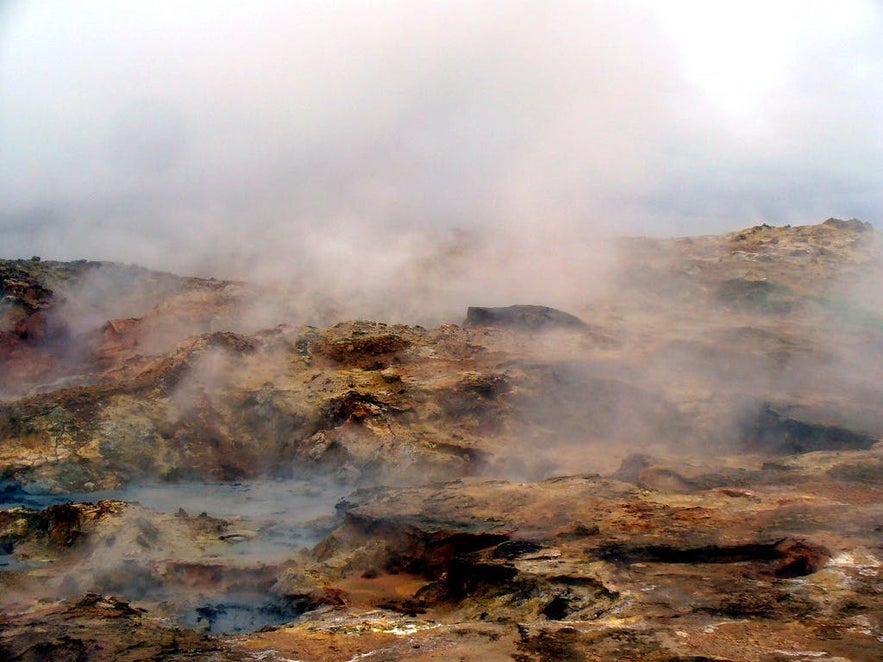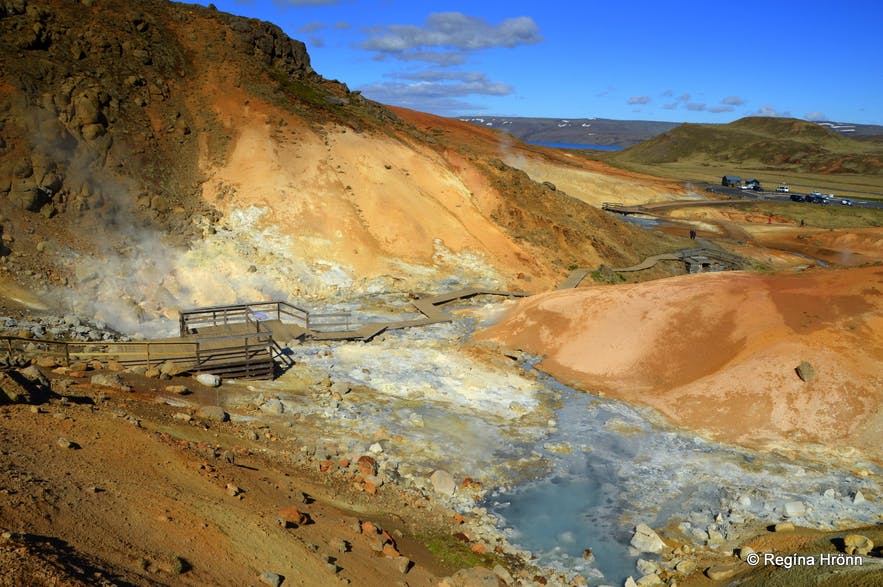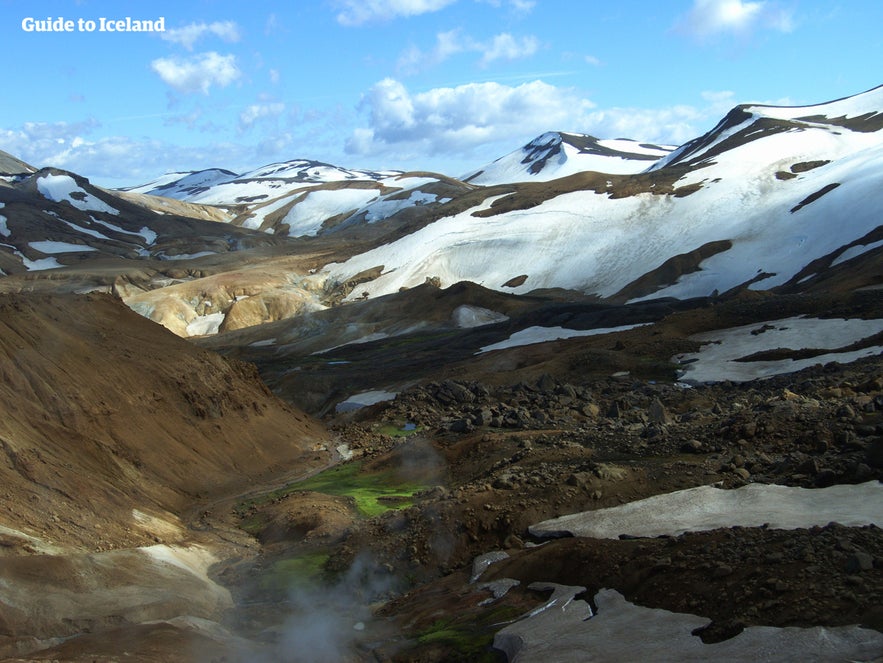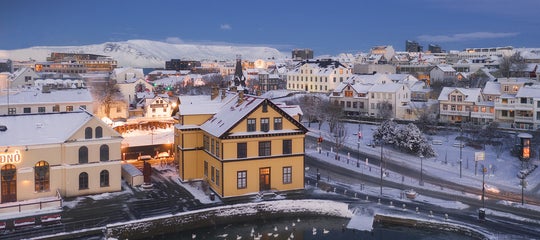
Geothermal Areas in Iceland

It’s no secret that Iceland boasts a geothermal underbelly, but where in the country can you see geothermal activity above ground? Where are the most accessible geothermal areas, and what geological features can be found there? Read on to find out all you need to know about geothermal areas in Iceland.
- Witness geothermal activity on a Landmannalaugar & Hekla Volcano Super Jeep Tour
- Plan some relaxing time with Admission to the Myvatn Nature Baths
- Read our Ultimate Guide to Driving in Iceland
Geothermal Energy in Iceland?
Iceland’s explosive volcanism very much justifies the latter half of its nickname, ‘The Land of Ice and Fire’. But aside from this country’s volcanoes, the most famous of which are, arguably, Hekla and Katla, evidence of Iceland’s formations can also be seen in its numerous geothermal sites.
Guests to Iceland are often fascinated by Iceland’s geothermal energy, viewing it as one example of the world sculpting itself in the present moment. The land has continued to flame and form since its birth—the southern island of Surtsey only appeared above the surface in 1963 following a calamitous underwater eruption that lasted until 1967!
A famous firsthand account of the formation of Surtsey beautifully encapsulates the changing landscape: "Where yesterday there was only ocean, today there is an island."

Many ancient cultures who had access to geothermal springs used them for bathing and socialising. But what exactly do these places look like?
Iceland's geothermal sites are many and varied; they range from geysers to hot springs. For the time being, we're only going to focus on geothermal sites in Iceland where bathing is not an option.
There are a number of establishments in Iceland designed to teach visitors about Iceland’s geothermal areas, including The Volcano House in Reykjavík and the Volcano Museum in Stykkishólmur, West Iceland and the Natural History Museum in Kópavogur. Those with only a short stopover in Iceland who want to learn about the country's fascinating geology might benefit from a visit to these centres rather than a day trip.
But nothing quite matches visiting a geothermal site for yourself. Thankfully, Iceland has a ton of them, each different from the last. Iceland’s geothermal valleys and hot springs have captured the imagination of poets, artists, and now, they'll have the chance to awaken your senses.
How Does Iceland Harness Geothermal Energy?

Heat and electricity prices in Iceland are generally quite low because of the use of geothermal power, meaning that the country's reliance on fossil fuels to heat its homes is minimal. However, only 30% of the energy produced in Iceland is geothermal; around 70% is hydroelectric. Geothermal heating, on the other hand, produces just over 80% of the country's heat and hot water requirements.
In 2000, the Icelandic GeoSurvey (ÍSOR), Orkuveita Reykjavíkur, Orkustofnun, and Hitaveita Suðurnesja, Landsvirkjun, and a number of international participants, undertook a project called the Iceland Deep Drilling Project (IDDP). According to the project's website, "the main purpose of the IDDP project is to find out if it is economically feasible to extract energy and chemicals out of hydrothermal systems at supercritical conditions ," - to date, the project has been able to drill to a depth of 4.6 kilometres.
In theory, these supercritical conditions could potentially produce 10x more energy out of every well (than a typical well).

And the reason that Iceland has all of this activity? Well, Iceland was formed from a magma pocket, otherwise known as “the Icelandic Hotspot”, which is a point on the earth where subterranean mantle is hotter and more active than the surrounding rock. Hotspots are independent of the position and movement of the tectonic plates, though Iceland sits at a noteworthy point regarding both features.
The sidewalks of both the capital city, Reykjavík, and the ‘capital of the north’, Akureyri, are heated from nearby underground springs, keeping snow clear (...in theory) from obstructing pedestrian traffic.
Geothermal energy is also used for heat in such attractions as the Blue Lagoon, located on the Reykjanes Peninsula and heralded as one of the country’s most popular visitor activities.
Harnessing geothermal energy in Iceland is not without its obstacles, however. Many recent proposals to invest in and construct new hydro dams in the Icelandic Highlands has been met with widespread opposition from environmental groups who fear nature is being squandered at the expense of economic process.
Multinational corporations often plan to utilise Iceland’s green energy because it is so cheap, threatening the landscape further.
- See Also: Iceland's Troubled Environment.
Namaskard Pass
Only a short distance from the glittering jewel that is Lake Mývatn, Námaskarð Pass, sitting at the base of Mt. Námafjall, might as well be a landscape from Mars. Whilst Námaskarð refers to the actual passage across the mountain ridge, the area is often referred to as either Hverarönd or Hverir.
- See Also: Things That Can Kill You in Iceland.
The region’s vivid red sands and towering pillars of steam instantly staple the area as unique, even in a country as eclectic and striking as Iceland. Visitors will also observe striking black rivers and bubbling pools, creating a strange ambience that the area is both dead and alive, all at once. Námaskarð Pass is located right beside Road 1, the circular route that stretches around the country.
Just as potent as the visual aesthetic is Námaskarð Pass’ aroma. This pungent, eggy stench strengthens the closer one steps towards the numerous mud pools and solfataras, proving almost immediately as to why no vegetation could possible grow here.
Haukadalur Valley | Geysir & Strokkur
The most famous geothermal area in Iceland is, without doubt, Haukadalur Valley. Home to both Geysir and Strokkur, two of the most famous hot springs in the world, Haukadalur is an essential third of the Golden Circle sightseeing route, often sandwiched between the UNESCO World Heritage site Þingvellir National Park and Gullfoss Waterfall.
Geysir is no longer regularly spurting water, but its fame lies in the fact that geysers across the planet are named after this original Icelandic word. Currently inactive, decades can pass by without the hot spring even murmuring; when eventually it does erupt, observers can expect a burst of water reaching as high as 70 metres into the air.
Strokkur behaves entirely differently, erupting every five to ten minutes and shooting water roughly twenty feet toward the sky. This reliable and natural display has secured Haukadalur as one of the country’s most unique draws, and has directly benefited the local community through tourist interest.
Gunnuhver
 Photo by Michael Held
Photo by Michael Held
Located close by to Reykjanes lighthouse, the area known collectively as Gunnuhver is one steeped in folklore, mystery and bubbling, subterranean energy. The area takes its name from the country’s biggest mud pool, otherwise known as Gunna hot spring.
The hot spring is named after a troubled young woman named Gunna who fell into conflict with the local sheriff. When she passed away, however, the sheriff still chose to attend her funeral. A few days later, he was found dead, covered in cuts and bruises, his bones broken.
When his remains were taken to Útskálar Church, the ghost of Gunna appeared in front of them, determined to drag the sheriff into the depths of hell.
The priest of the church, Gísli, stood against her, fighting throughout the night to save the sheriff's soul. And though this time she was unsuccessful, the ghost would go on to make life on the Reykjanes Peninsula a living nightmare; the sheriff's wife would quickly perish, as well as numerous others, and locals began to experience bouts of madness. Clearly, something had to be done about this filthy poltergeist…
- See Also: Folklore in Iceland.
Finally, a solution was concocted in the mind of two locals farmers and the priest. What they really needed was a place to trap Gunna, a place from where she could never escape. Having conspired together, it was decided that the farmers would trick the ghost into holding onto one end of a rope, whilst the other end would be knotted and weighed down.

Upon handing Gunna the rope, the knotted side was thrown into the hot spring, dragging the ghost into an inescapable hiding place. Ever since, the Reykjanes Peninsula has known peace.
Gunnuhver sits neatly in the middle of the Reykjanes’ UNESCO Global Geopark, making it a quick visit for those leaving from Keflavík International Airport (KEF). Whilst in the area, you could also pay a visit to another geothermal site, the Blue Lagoon Spa, and gain an insight into Iceland’s fascinating geology at the ‘Bridge Between The Continents’.
Hveravellir Nature Reserve
Hveravellir is another amazing example of Iceland's incredible geothermal underbelly, offering its guests the typical sights and sounds associated with these most lively of Icelandic vistas. Translated to “Hot Spring Fields”, Hveravellir is considered an oasis in the Highlands, a place where hikers can take a short break to eye something truly unique.
Situated directly between Langjökull and Hofsjökull, Hveravellir is one of the bigger geothermal areas in Iceland, boasting some hot springs that must be appreciated from a safe distance. Located besides the Visitor's Centre is a hot pool to bathe in, constructed in 1950 and measuring at between 8 - 39 degrees C, given the time of year.
At Hveravellir, visitors will have the chance to see hot springs by colour code; the blue hot spring, Bláihver, the green hot spring, Grænihver, or the red hot spring, Rauðihver. One can also discover the hot spring Öskurhóll, named as “The Roaring Mound” by Eggert Ólafsson and Bjarni Pálsson after they discovered the feature in 1752.
Seltun Geothermal Area
 Photo by Regína Hrönn Ragnarsdóttir
Photo by Regína Hrönn Ragnarsdóttir
Seltún geothermal area is also found on Reykjanes peninsula, meaning it is within easy access from the capital. Located right beside the Ring Road, this area is also known as Seltúnshverir (the hot springs at Seltún) or Krýsuvíkurhverir (the hot springs at Krýsuvík).
Criss-crossed with wooden walkways, with two large observation platforms, guests to Seltún will be able to look across the site’s fumaroles, boiling mud pots and steaming solfataras.
Another attraction in the area to visit—though its name may put you off (...don't let it)—Fúlipollur, literally translated to "Foul smelling puddle". This enormous black mud pool is located beside Road 42, and there is a designated parking area for those brave enough to take a closer look.
A final point of interest, only a few kilometres south, is the explosion crater Grænavatn. The name translates to ‘Green Lake’, its title clearly taking inspiration from the waters peculiar emerald aura. This shade is due to the high levels of sulphur contained within the lake, though this fact, over the years, hasn’t stopped locals from imagining the lake beholds supernatural qualities. It was only in the 16th Century that local farmers spotted a mysterious creature appearing from the lake…
Hengill Geothermal Area .

South of Þingvellir National Park, one of Iceland’s most active volcanoes, you can find Mount. Hengill, covering a total area of 100 km². Despite the energy bubbling beneath the surface, the last eruption at Hengill occurred over 2000 years ago, meaning it has since been utilised as an important energy source for Iceland’s south west.
Nesjalaugar and Köldulaugar geothermal areas are both a part of the larger Hengill area, itself a part of Reykjadalur Valley, a popular area for hikers and hot spring hunters. As expected, both of these incredible areas have an array of routes for the avid trekker, showcasing some of the most beautiful and eclectic scenery that can be found in Iceland.
Köldulaugar refers to "Cold Pools". This is despite evidence of the heat all around you, whilst Nesjalaugar means "Pools of the Peninsula." Thankfully, a series of hiking trails makes walking through this area a true delight, complimented all the more by stunning swathes of Icelandic scenery.
This is one area where cameras are a true necessity; watching the landscape burn and bubble beneath you almost defies belief.
 Photo by Wikimedia. Creative Commons, by Asgeir Eggertsson. No edits made.
Photo by Wikimedia. Creative Commons, by Asgeir Eggertsson. No edits made.
Ölfusvatnslaugar, also called Hagavíkurlaugar, is another popular geothermal spot in the local area. It is a popular destination for geothermal helicopters tours, who will fly from Reykjavik Domestic Airport out over the Icelandic wilderness, landing at some of the most active and inaccessible spots.
In this area, you will also have a chance to check out Hellisheiðarvirkjun, the largest geothermal plant in Iceland, and the third largest geothermal plant in the world. Hellisheiðarvirkjun is responsible for Reykjavik’s heating, and offers education tours on sustainable energy and tourism.
Kerlingarfjoll Mountain Range

The Kerlingarfjöll area was once known for its popular ski resort, though this was dismantled before the start of the millennium. Since 2000, a highlands centre has provided accommodation and food to guests travelling through the area.
March 17, 2017, saw both the Kerlingarfjöll mountain range and the geothermal area become a protected nature reserve within the Icelandic highlands. This now means that 367 square kilometres of land are officially protected by the state of Iceland, putting an end to any potential geothermal plants that were being considered for construction in the area.

Visitors to Kerlingarfjöll can expect a landscape characterised by its colourful hillsides, rising towers of steam and obsidian rock deposits. The unique colour is derived from the mountains’ youth; the rhyolite stone, approximately 10,000 years old, appears to change colour in the passing light, creating a kaleidoscopic effect. Certain areas of the reserve boast hot springs measuring up to 140 degrees Celsius, whereas in another area you can enjoy the perfect temperature for a hot spring bath.
Did you enjoy our article, Geothermal Areas in Iceland? Which geothermal areas did you visit during your time in the country? Make sure to leave your thoughts and queries in the Facebook comments box below.
Andre spændende artikler

Besøg Island i januar | Den ultimative guide
Lær alt, hvad der er at vide, om at besøge Island i januar. Det er en af de bedste måneder, hvor du kan opleve mange af Islands største attraktioner, såsom isgrotter, gletsjervandring og nordlysjagt...Læs mereBesøg Island i maj | Ting at se og lave
Opdag, hvorfor det er et godt valg for din næste ferie at rejse til Island i maj. Lær om vejret på Island i maj, og hvilke aktiviteter du kan deltage i, mens du er der. Læs videre og udforsk de beds...Læs mereDen komplette guide til gletsjerlagunen Jokulsarlon
Lær alt, hvad du har brug for at vide, for at planlægge din tur til gletsjerlagunen Jokulsarlon på det sydøstlige Island. Denne islagune er blevet en af Islands mest populære attraktioner på grund a...Læs mere

Download Islands største rejsemarkedsplads til din telefon for at administrere hele din rejse på ét sted
Scan denne QR-kode med dit telefonkamera, og tryk på det link, der vises, for at lægge Islands største rejsemarkedsplads i lommen. Indtast dit telefonnummer eller din e-mailadresse for at modtage en sms eller en e-mail med downloadlinket.



























